ABSTRACT
In an attempt to find out the reasons of pomegranante fruit drop due to insect attacks, regular collection of all fallen fruits beneath trees of nine different varieties was done during the fruiting season from August 2013 to December 2013 in an organic pomegranate orchard in the Chott-Mariem region of Tunisia. Apparently heatlthy and cracked fruits were dissected in the laboratory to identify insect larvae found inside. Results indicate that fruits were attacked by three larvae insect species: the Mediterranean fruit fly, Ceratitis capitata Wiedemann (Diptera, Tephritidae), the carob moth, Ectomyelois ceratoniae Zeller (Lepidoptera, Pyralidae) and the pomegranate butterfly, Virachola livia Klug 1834 (Lepidoptera, Lycaenidae). Two different insect larvae can be found jointly inside fruits but no fruits were attacked by the three insect larvae together. All fruits varieties harbor the larvae of C. capitata whereas E. ceratoniae larvae were present in eight of nine varieties. Varieties numbered 1, 8 and 9 were free from V. livia larvae attacks and hence can be considered as resistant cultivars. With respect to Lepidoptera larvae attacks (E. ceratoniae and V. livia), we can assume Variety 1 as resistant. Nevertheless, more research was needed to corroborate these results.
Key words: Pomegranate, fruit drop, Ectomyelois ceratoniae, Virachola livia, Ceratitis capitata.
Pomegranate, Punica granatum L. native to Persia is widely cultivated througout Iran, India, the drier parts of South-East Asia, Mediterranean region, Africa and dry hot areas of the United States and Latin America (Glozer and Ferguson, 2011; Mansour, 1995). The pomegranate is cultivated for its edible fruits and/or for decorative purposes. Its utilization consists of a large number of horticultural varieties mainly characterized by fruits traits such as fruit and seed color, taste and shape. The tree has been traditionally cultivated since ancient times under diverse climatic conditions (Evreinoff, 1957; Mars, 1995). Fruits are consumed fresh or processed for juice, syrup and other purposes. Different parts of the pomegranate tree (leaves, fruits and bark skin) have been used tradionally for the medicinal properties and for other purposes such as tanning (Mars, 2000). In Tunisia, pomegranate tree is well known in the coastal regions of the north, the center and the south and in many areas inside the country. It is also considered as a principal fruit tree in the oases. Local varieties are numerous and well adapted to agroecological conditions (Mars, 1995). Having long been considered as a secondary and non commercial plantation, pomegranate cultivation has increased recently due maily to the greater awareness of its benefit to human health confirmed by recent scientific findings (Gil et al., 2000; Lansky and Newman, 2007). In Tunisia, the cultivated area extended from 5650 ha in 1980 to 11300 ha in 2008 given a production of 75000 tons in 2009 (Anonymous, 2014). Currently, the cultivation of pome-granate is experiencing several problems apart from pest attacks such as fruit cracking, fruit rot and fruit dropping. Insect pests of the fruit can cause major problems; one of these pests is the carob moth Ectomyelois ceratoniae Zeller 1839 (Lepidoptera, Pyralidae) (Gothilf, 1969), in which the female lays eggs in the calyx of developing fruits, and in a few days, the caterpillars enter the fruit by way of the calyx and cause arils rot. In Tunisia, Dhouibi (2000) reported the yearly damage rate caused by E. ceratoniae on Pomegranate fruits from 1996 to 1999 varied from 29 to 72% reaching 90% in 1983. Recently, increased damages of the pomegranate butterfly, Virachola livia Klug 1834 (Lepidoptera: Lycaenidae), was reported by Ksentini et al. (2011) causing fruit rot. These fruit borers may cause loss of an entire crop. More recently, we observed increased symptoms of damage similar to Mediterranean fruit fly Ceratitis capitata Wiedemann 1824 (Diptera, Tephritidae) attacks. C. capitata was reported as pomegranate pest in Turkey, Spain and other regions of the Mediterranean (Özturk et al., 2005; Özturk, and Ulusoy, 2009; Juan et al., 2000; Delrio and Cocco, 2012). Pomegranate cultivation and its potential yield are affected by many disorders like fruit cracking, fruit splitting and fruit drop. Beside the fall of fruits after fruit set occuring usually in May-June, the drop of mature fruits is common generally assigned to insect attacks mainly E. ceratoniae. Therefore, it is necessary to know the causes of fruit falling properly and determine which insect species are responsible to permit better control alternatives.
Experimental site
The study was conducted in an experimental organic pomegranate orchard belonging to Research Center for Horticulture and Organic Agriculturein Chott-Mariem (Sousse, Tunisia 35.8°North ; 10.6° East). The area is located in the eastern coast of the Mediterranean at about 2.5 km far from the sea and characterized by a semi-arid climate with hot summers and mild winters. Monthly average temperatures in 2013 varied from 10.56°C in January to 28.62°C in August obtained from a meteological station situated at about 2 km from the study site belonging to the National Researches Institute of Rural Engeneering, Water and Forest (Tunisia). Annual rainfall recorded is about 300 mm concentrated mainly between October and April. The orchard, four years aged of about 0.25 ha was divided into two plots of the same area seperated by a path of 6 meters wide. The study plot is composed of 9 rows of 12 trees each for a total of 108 unsprayed trees. On the row, trees were seperated by 2.5 m and 3.5 m between the lines. The plot is surrounded in the North by a plot of fig tree (Ficus carica), in the south by a plot of olive tree in the west by a the second plot of pomegranate, of the same area having the same varieties and in the East by a bare land. Drip irrigation was used. Each row was planted with a different variety; thus, nine different local commercial cultivars were represented in which sour, sour-sweet and sweet varieties are represented (Dr. Mars, personal communication). Since the ongoing research of pomological characteristics of each variety conducted by Dr Mars’s team, each cultivar was refered here as VAR1, VAR2 to VAR9.
Fruit collection and handling
The collection of fallen fruits was undertaken during the fruiting season (from 23 August 2013 to 6 December 2013). Fallen fruits (Figure 1) were collected usually at biweekly interval beneath each tree for each row (variety) and transported to the laboratory where they were dissected. Larvae found inside fruits were categorized as Dipteran or Lepidopteran larvae. For Lepidopteran species, only insect larvae were taken into account since we cannot differentiate species at eggs or pupae stages. Hence, larvae were categorized as V. larvae (Figure 2), E. larvae (Figure 3) or fruitflies larvae C. capitata (Figure 4). E. ceratoniae larvae were identified according to Solis (2006), V. livia according to Hanna (1939) and C. capitata according to Balachowsky et Misnil (1935). Extremely rotten fruits were eliminated and were not included as considered as attacked by Drosophila melanogaster Meigen (Diptera, Drosophilidae) larvae. D. melanogaster is specialized to feed as larvae on rotting vegetable matter that is undergoing fermentation due to yeast or bacterial contamination (EOL, 2014) or attacked by the fungus Alternaria spp. (Kahramanoglu et al., 2014).
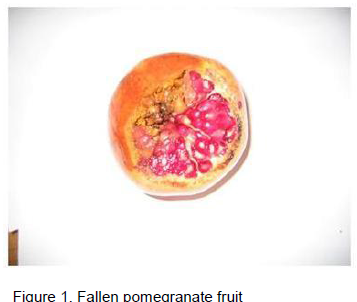
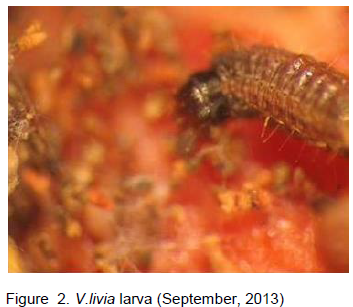
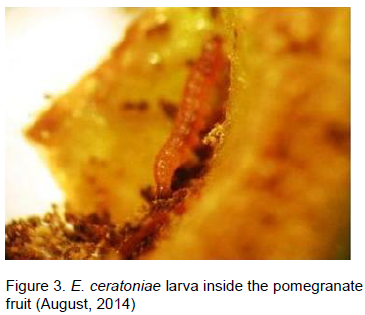
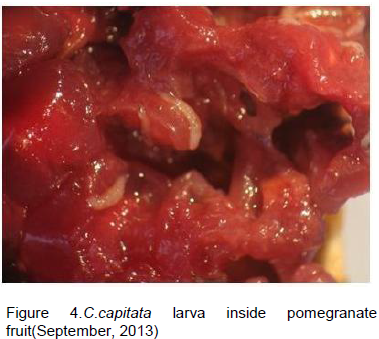
Statistical analysis
The mean number of fallen fruits either attacked by insect larvae or un-attacked according to varieties were submitted to one way ANOVA using the software SPSS 17.0 (SPSS, 2008). Dates of collection were considered as repeated data. When significant difference was detected, a Duncan’s multiple Range test was used to separate means at P≤0.05.
Total number of fallen fruits
The total number of fallen fruits during the collection period (from August 23, 2013 to December, 6 2013, 25 collec-tion dates) shows significant difference among varieties (One-way ANOVA; F8,216= 5.133; P=0.001). The varieties numbered three and four suffer more fruit drop and variety number seven undergoes low fruit drops (Figure 5). Indeed VAR3 and VAR4 suffered significant fruit drops not caused by insect attacks (Table 1). The number of fallen fruits presumably caused by insect attacks, due to the presence of larvae inside fruits shows significant difference among varieties (Table 1). Indeed variety 1 harbors less insect larvae and variety 2 shows maximum attack even though the two varieties are located side by side. The less insect attacks in variety 1 may be attributed to the amount of acid content of this variety as reported by Melgarejo et al. (2000). This is confirmed by detailed insect larvae attack in which only C. capitata larvae were found in fallen fruits of variety 1 (Table 1) in only one date (on 31 October 2013).


The details of insect damages show significant differences among cultivars regarding Lepidoptera larvae; E. ceratoniae and V. livia. Larvae attacks were assigned to E. ceratoniae more than V. livia (Table 2). All varieties were more attacked by E. ceratoniae larvae than V. livia larvae. Thus Moawad et al. (2011) reported that V. livia attacks healthy pomegranate fruits whereas E. ceratoniae attacks cracked fruits.
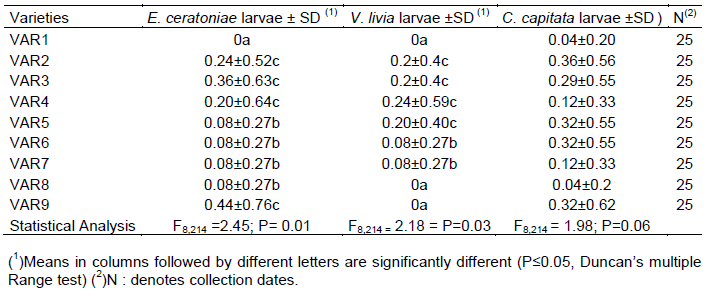
Insect infestation within varieties
The within variety insect larval densities (E. ceratoniae, larvae, V. livia larvae and C. capitata larvae showed no statistical difference for all varieties except variety 9 (one way ANOVAs; Variety 1:F2,72=1; P= 0.373; Variety 2: F2,72=0.60 P=0.50; Variety 3: F2,72= 0.55 P=0.57; Variety 4 : F2,72=0.37, P=0.72; Variety 5: F2,72=1.9, P=0.14; Variety 6: F2,72=3.10, P=0.052; Variety7: F2,72=0.15, P=0.89; Variety 8: F2,72=3.10, P=0.052 and Variety 9: F2,72=3.9, P=0.02). C. capitata larvae were present in all varieties without real distinction between cultivars. This can be explained by (1) the insect has no choice among pomegranate varieties and thus pomegranate fruits can be considered as primary hosts. Indeed, if the C. capitata female has to choose among hosts present in the area, it would prefer several ripe fruits available. There were fig fruits, Ficus carica and two citrus species Citrus sinensis cv Thomson and C. clementina Hort. ex Tanaka. Indeed, in Morocco, Fahad et al. (2014), studying the biology and ecology of the Mediterranean fruit fly on Rosaceous tree in the Sefrou region, reported high C. capitata male captures in sexual traps installed in pomeganate orchard. However, no data were given regarding fruit infestation; and (2) the insect attacks already dropped fruits in which decaying process has begun and therefore, the insect has no real choice regarding the fruits characteristics such as color, thickness and shape. All varieties were attacked by E. ceratoniae larvae except variety 1 which is also free of V. livia larvae. Varieties 1, 8 and 9 were free from V. livia larvae which can be considered as resistant varieties. With respect to Lepidoptera larvae attacks, we can consider variety 1 as a resistant variety.
Presence versus absence of larvae species inside fruits
When we consider all varieties, for the presence-absence of the three insect larvae species, the larvae of E. ceratoniae were present solitary in the fruits at the percentage of 40%; exceeding V. livia and C. capitata larvae (Figure 6). Fruits can be attacked jointly by two different insect species (C. capitata plus E. ceratoniae; C. capitata plus V. livia; and E. ceratoniae plus V. livia) but no fruits were found attacked by the three insect species perhaps due to cannibalism between larvae (Figure 6).
To our knowledge, this is the first study to deal with the reasons of pomegranate fruit drop due to insect attacks in the centre-East region of Tunisia although Ksentini et al. (2011) when reporting the first occurrence of V. livia in Tunisia mentioned 5.2% of fruits were infested by V. livia and the insect was responsible for 52% of fruit rot in 2006 in Gabès governorate (South).
Better knowledge of the causes of fruit drop is important for these reasons (1) when establishing new orchard, the choice of varieties is of paramount importance. Determing which of pomegranate varieties are suscep-tibles, tolerants or resistants to insect attacks especially for the major Lepidoptera species (E. ceratoniae and V. livia) is crucial (Fesharaki et al., 2011) and (2) the insect pests responsible for fruit drop can be controlled efficiently. The rotten and decaying fruits showing no insect larvae may be infected by the fungus Alternaria spp. as reported by Kahramanoglu et al. (2014) in Cyprus. Indeed, Moawad et al. (2011) investigated the insect attacking five different pomegranate varieties in Saudi Arabia and reported three species: V. livia, E. ceratoniae and Pseudococcus maitimus. They stated the local variety (Al-taif) was resistant to V. livia larvae and the imported variety Wondeful was more resistant to E. ceratoniae larvae. In Turkey, Özturk et al. (2005) reported seven key insects attacking pomegranate in the Eastern Mediterranean Region of Turkey which are: E. ceratoniae (Zell.) (Lep.: Pyralidae), C. capitata Wied. (Dip.: Tephritidae), Aphis punicae Passerini (Hemiptera Aphididae), Siphoninus phillyreae (Haliday) (Hem.: Aleyrodidae), Planococcus citri (Risso) (Hemiptera:
Pseudococcidae), Zeuzera pyrina (L.) (Lep.: Cossidae) and Carpophilus spp. (Col.: Nitidulidae).
In our study beside the Med fly, two Lepidopteran species were present in fruits having more or less similar biologies. Shortly after hatching, larva needs to establish a feeding site, negotiating some or all of the following: leaf hairs, surface waxes, hard plant parts, laticifers, glands or tissues filled with allelochemicals, locally induced plant changes, variable microenvironments, predators, pathogens, and parasitoids (Zalucki et al., 2002). The control of C. capitata is relatively easy using insecticide bait stations or cover sprayers. However, the control of Lepidoptera species is tricky and needs to monitor insect adult flight by the use of pheromones which are commercially lacking.
Author did not declare any conflict of interest.
The author wish to thank Dr Mars M. Director of the Regional Research Center for Horticulture and Organic Agriculture to permiting the use of pomegranate orchard. I thank Miss Bendhiefi A. and Mr Chtiwi L. for the technical assistance.
REFERENCES
|
Anonymous (2014). www.agriportail.tn. accessed 11 November 2014.
|
|
|
|
Balachowsky AL, Misnil L (1935). Les insectes nuisibles aux plantes cultivées: leurs mœurs, leur destruction. Traité d'entomologie agricole concernant la France, la Corse, l'Afrique du nord et les régions limitrophes, Volume 1. Les Presses des établissements Busson, sous la direction technique de L. Méry, (Eds). Paris. 242-253 (in French)
|
|
|
|
|
Delrio G, Cocco A (2012). Integrated Control of Citrus Pests in the Mediterranean Region. Chapter 15.Tephritidae.Vincenzo Vacante and Uri Gerson (Eds).Bentham Sciences Publishers. pp. 206-222.
|
|
|
|
|
Dhouibi MH (2000). Lutte intégrée pour la protection du palmier dattier en Tunisie. Centre de publication universitaire. Tunis (Tunisia), 140 p (in French).
|
|
|
|
|
EOL (2014). Encyclopedia of life. Eol.org. accessed 18 November 2014.
|
|
|
|
|
Evreinoff VA (1957). Contribution à l'étude du grenadier. J. d'Agriculture tropicale et de botanique appliquée. 4. N°3-4(124-138).
CrossRef
|
|
|
|
|
Fahad K, Gmira N, Benziane T, Sekkat A (2014). Etude de la bio-écologie de la moucheméditerranéenne des fruits Ceratitis capitata Wiedemann (1824) sur Rosacées dans la région de Sefrou (Maroc). Entomologie Faunistique – Faunistic Entomol. 67: 85-95.
|
|
|
|
|
Fesharaki SH, Karimizadeh J, Jalalzand AR,Besharatnejad MH, Modaresi M (2011). Studying on Damage of Carob Moth in Three Pomegranate cultivars of Isfahan (Iran). Procedia Environmental Sciences 8: 257 – 261
CrossRef
|
|
|
|
|
Gil MI, Tomas-Barberan FA, Hess-Pierce B, HolcroftDM, Kader AA (2000). Antioxidant Activity of Pomegranate Juice and its Relationship with phenolic composition and processing. J. Agric. Food Chem. 48: 4581−4589.
CrossRef
|
|
|
|
|
Glozer K, Ferguson L (2011). Pomegranate production in Afghanistan. UC Davis. College of Agricultural and Environmental Sciences. 1-32.
|
|
|
|
|
Gothilf S (1969). The biology of the carob moth Ectomyelois ceratoniae (Zell.) in Israel. Effect of food, temperature and humidity on development. Israel J. Entomol. IV: 107-116.
|
|
|
|
|
Hanna AD (1939). The pomegranate fruit butterfly Virachola livia Klug : Morphology, life history and control. Entomological Section. Bulletin Number 186. Government Press (Bulâq). 54 p.
|
|
|
|
|
Juan P, Martinez JJ, Oltra MA, Ferrandez M (2000). Current situation of pomegranate growing (Punica granatum) in southern Alicante. Chemical control of pests and diseases and financial cost. Options Méditerranéennes Séries A. Séminaires Méditerranéenns. 42:157-161.
|
|
|
|
|
Ksentini I, Jardak T, Zeghal N (2011). First report on Virachola livia Klug. (Lepidoptera: Lycaenidae) and its effects on different pomegranate varieties in Tunisia. Bulletin OEPP/EPPO Bulletin. 41:178–182.
|
|
|
|
|
Lansky EP, Newman RA (2007). Punica granatum (pomegranate) and its potential for prevention and treatment of inflammation and cancer. J. Ethnopharmacol. 109(2): 177-206.
CrossRef
|
|
|
|
|
Mansour KM (1995). Underutilized fruit crops in Egypt. Cahiers. Options Méditerranéennes. 13-19.
|
|
|
|
|
Mars M (1995). La culture du grenadier (Punica granatum L.) et du figuier (Ficus carica L.) en Tunisie. Cahiers Options Méditerranéennes 13:85-95.
|
|
|
|
|
Mars M (2000). Pomegranante plant material: genetic resources and breeding, a review. Options méditerranéennes. Série A. Séminaires Méditérranéens 42: 55-62.
|
|
|
|
|
Melgarejo P, Salazar DM, Artes F (2000). Organic acids and sugars composition of harvestedpomegranate fruits, Eur. Food Res. Technol. 211(3):185–190.
CrossRef
|
|
|
|
|
Moawad SS, Hassan SA, Al-Barty AM (2011). Enumeration and estimation of insect attack fruits of some cultivars of Punica granatum. Afr. J. Biotechnol. 10(19):3880-3887.
|
|
|
|
|
Kahramanoglu I, Uzanmaz S, Nizam I (2014). Incidence of heart rot at pomegranate fruits caused by Alternaria spp. in Cyprus. Afr. J. Agric. Res. 9(10): 905-907.
|
|
|
|
|
Özturk N, UlusoyMR, Bayhane E (2005). Pest and natural enemy species determined in pomegranate orchards in the Eastern Mediterranean Region, Turkey. Türk. Entomol. Derg. 29 (3): 225-235.
|
|
|
|
|
Özturk N, Ulusoy MR (2009). Pests and natural enemies determined in pomegranate orchards in Turkey. Acta Hort. (ISHS) 818:277284.
|
|
|
|
|
Solis MA (2006). Key to selected Pyraloidea (Lepidoptera) larvae intercepted at U.S. ports of entry. Revision of Pyraloidea in Keys to some frequently intercepted Lepidopterous larvae by Wiseman (1986) USDA Systematic Entomology Laboratory. Paper 1.
|
|
|
|
|
SPSS (2008). Spss Statistics for windows 17.0. Chicago.Il.USA.
|
|
|
|
|
Zalucki MP, Clarke AR, Malcolm SB (2002). Ecology and behavior of first instar larval lepidoptera. Annu. Rev. Entomol. 47:361–393.
CrossRef
|
|